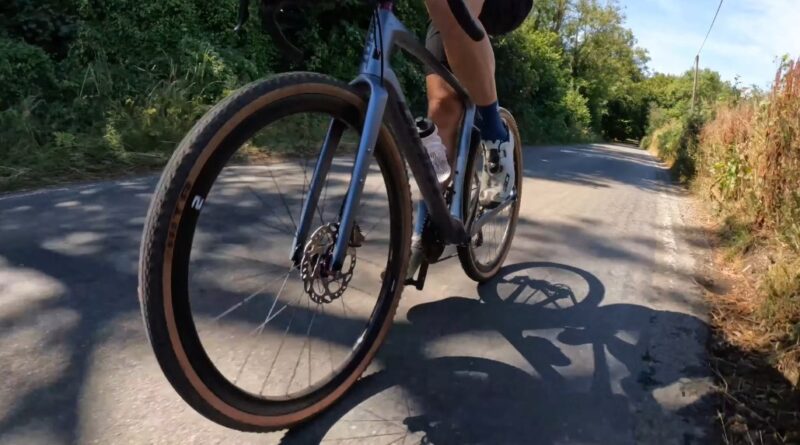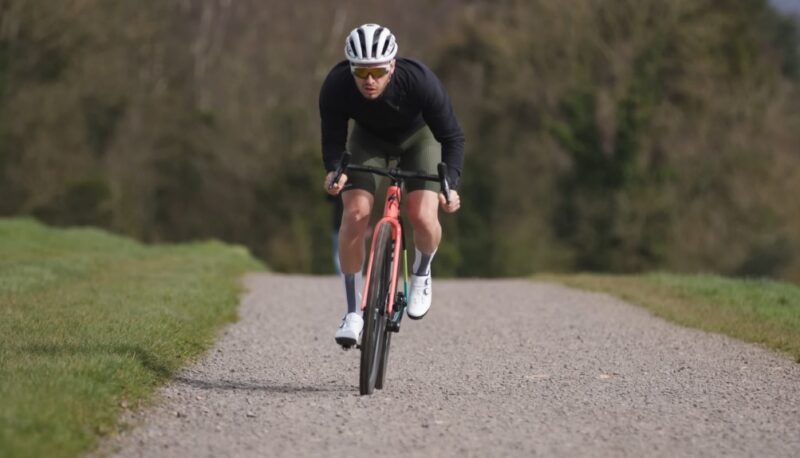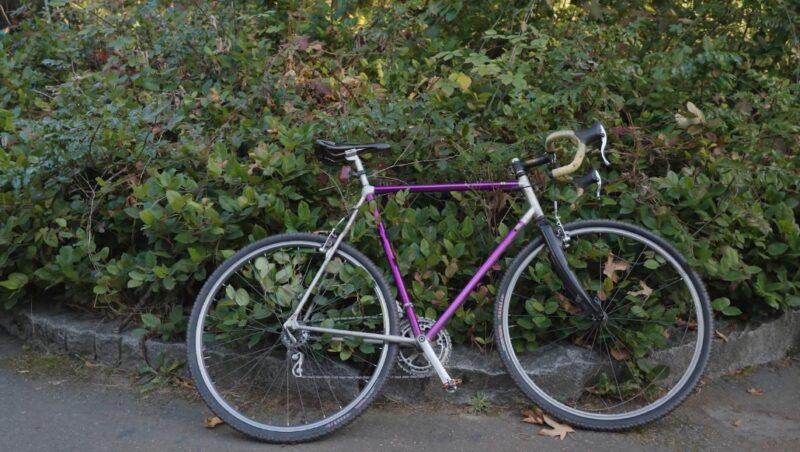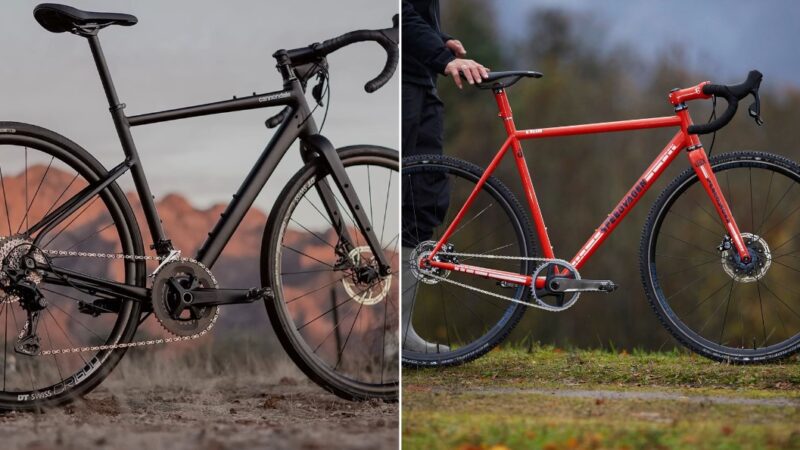So, you’re eyeballing a new bike, and you’re stuck between a cyclocross and a gravel bike. Maybe you’ve heard the terms tossed around in your local bike shop, or perhaps a buddy of yours swears by one and looks down on the other.
Well, sit tight, because I’m going to break down the key differences, give you the straight facts, and maybe throw in some extra tips for good measure. Let’s get started.
Table of Contents
ToggleIt’s All About the Angles
Cyclocross bikes and gravel bikes might look similar at first glance, but their geometries are as different as night and day. Cyclocross bikes feature a higher bottom bracket, shorter chainstays, and a lower stack height.
Why? Because they’re designed for nimble handling and quick accelerations, perfect for dodging obstacles and making tight turns on race courses.
On the other hand, gravel bikes sport a longer wheelbase and a lower bottom bracket. This makes them stable for those long, meandering rides through the countryside. If you’re planning to spend hours in the saddle, trust me, you’ll appreciate the extra stability.
Think of it as the difference between a sports car and a comfy SUV. One’s built for speed and agility, the other for comfort and endurance.
Storage Solutions
Cyclocross races are short and intense, so there’s no need for extra storage. These bikes are stripped down for speed—no mounts for racks, fenders, or any of that nonsense.
If you need to carry anything, you’re probably in the wrong race, my friend. Gravel bikes, however, are the Boy Scouts of the bike world: always prepared.
They come with mounts for everything—racks, fenders, multiple water bottles, and even bags.
Gearing

Cyclocross bikes typically roll with a 46/36 chainring paired with an 11-36 cassette. This setup ensures a consistent cadence and quick power transfer, perfect for the short, punchy climbs you’ll encounter in a cyclocross race, weather as a domestique or a race leader.
Gravel bikes are more versatile when it comes to gearing. You’ll often find them equipped with a 50/34 or 48/32 chainring and an 11-34 cassette. This gives you a wider range to tackle various terrains, from smooth tarmac to gnarly off-road trails.
Essentially, gravel bikes are the chameleons of the cycling world – able to seamlessly adapt to a wide variety of terrain and conditions, from smooth pavement to rugged backroads. They’re the cycling equivalent of an all-terrain vehicle.
On the other hand, cyclocross bikes are more like Formula One race cars – meticulously engineered for maximum performance on a specific course, with no compromises. They excel on the tight, technical circuits of cyclocross races but would feel out of place navigating the unpredictable surfaces of a gravel adventure.
Wheels & Tires
Cyclocross bikes are constrained by racing regulations, which limit tire width to 33mm. They usually roll on 700c wheels. If you’ve ever tried to squeeze a wider tire in there, you know it’s not happening. Gravel bikes, however, are all about options.
They can accommodate wider tires, often up to 42mm on 700c wheels, and even fatter tires if you go with 650b wheels.
Comfort & Stiffness

Cyclocross bikes are built stiff for one reason: efficient power transfer. That means more of your pedaling energy goes into speed, not into flexing the frame. Great for races, but your posterior might not be feeling so hot after an hour or two.
Gravel bikes, on the other hand, prioritize comfort. Manufacturers use special carbon layups and unique tube shapes to absorb vibrations from rough roads and trails. So if you’re planning on spending hours in the saddle, a gravel bike will be much kinder to your backside.
Jack of All Trades vs. Master of One
Cyclocross bikes are specialists. They’re designed for racing on specific courses with specific rules, good for drafting and other race maneuvers. That means they excel in their niche but might not be the best choice outside of it. Gravel bikes are the generalists of the cycling world.
They can handle a variety of conditions, from smooth pavement to rough trails. It doesn’t matter if you’re bikepacking, exploring multi-terrain routes, or even entering a gravel race, gravel bikes are up for the challenge.
Dual-Use Possibility

Sure, you can use a cyclocross bike for gravel riding and vice versa, but each has its optimizations. A cyclocross bike might feel a bit harsh and twitchy on long gravel rides, while a gravel bike might feel sluggish on a tight cyclocross course.
Think of it as wearing dress shoes to a hiking trip—you can do it, but you’ll likely regret it, especially if you experience bonking.
Common Features
Despite their differences, cyclocross and gravel bikes share some common traits. Both sport drop handlebars, knobbly tires, rigid frames, and wider tire clearances compared to road bikes. They’re both designed to take you off the beaten path, just in slightly different ways.
My Suggestion (If You Opt For Cyclocross)
CUBE CROSS RACE C:68X TE – Carbon Cyclocross Bike
The Cube Cross Race C:68X TE is a high-performance cyclocross bike built for serious racers. Its ultra-light C:68X carbon frame, weighing under 900g, gives it the agility and responsiveness you need for quick accelerations and sharp turns on challenging courses.
The integration of Shimano’s Ultegra Di2 electronic shifting ensures precise gear changes, while the hydraulic disc brakes provide powerful and reliable stopping power in any conditions.
What stands out is the bike’s attention to efficiency and comfort. With a carbon Newmen wheelset and an integrated Wing Bar handlebar, the bike optimizes power transfer while staying comfortable over long, rough rides.
It’s lightweight yet strong, making it easy to carry during run-ups, and the internal cable routing keeps everything clean and aerodynamic.
Key Features
| Feature | Description |
|---|---|
| Frame Material | C:68X® Carbon, Advanced Twin Mold Technology |
| Drivetrain | Shimano Ultegra Di2 2×12 electronic shifting |
| Brake System | Shimano Ultegra BR-R8170 hydraulic disc brakes |
| Wheelset | Newmen Advanced SL X.R.36 Carbon |
| Weight | 7.4 kg (with a frame under 900g) |
My Suggestion (If You Opt For a Gravel Bike)
Bianchi IMPULSO COMP – GRX 610
The Bianchi Impulso Comp GRX 610 is a great choice for riders who want a versatile gravel bike that can handle both road and mixed terrains without compromising speed or control.
The carbon fiber frame and fork ensure a lightweight build, which makes climbing and fast-paced gravel rides feel smooth and responsive.
Paired with Shimano’s GRX 610 2×12 drivetrain, it offers precise shifting and a wide range of gears to tackle steep climbs or sprints with ease. The hydraulic disc brakes deliver excellent stopping power even on tough descents.
What I appreciate most about the Impulso Comp is its blend of comfort and performance. The Fulcrum RapidRed 900 wheels, combined with tubeless-ready Pirelli Cinturato tires, provide great traction and reduce the chance of flats, which is perfect for long rides on rugged terrain.
With a well-thought-out design, including internal cable routing and wide tire clearance, this bike feels ready for any adventure, whether you’re racing or exploring off the beaten path.
Key Features
| Feature | Description |
|---|---|
| Frame | Carbon fiber, internal cable routing, lightweight |
| Drivetrain | Shimano GRX 610 2×12-speed, 46/30T chainring, 11-36T cassette |
| Brakes | Shimano hydraulic disc brakes, 160mm rotors |
| Wheels | Fulcrum RapidRed 900, tubeless-ready |
| Tires | Pirelli Cinturato Gravel H, 700x40mm, optimized for rough terrain |
Which One is Right for You?
When it comes to choosing between these two bikes, it really comes down to how you plan on using them. If you’re the type who loves the thrill of racing, navigating tight courses, and riding with an edge, a cyclocross bike is probably right up your alley.
But if you’re more into exploring, going on long-distance adventures, and just wanting a versatile ride, then a gravel bike is likely the way to go. So there you have it.
If you’re envisioning yourself blasting through mud and hopping over barriers, or going on some epic gravel escapades, now you know which bike is going to suit your needs best.
Related Posts:
- Cyclocross vs. Gravel Bike - 7 Key Differences You…
- How Fast Can A Dirt Bike Go? - Difference in 13 Engine Sizes
- The Complete Guide to Steel Gravel Bikes
- Are Shimano Clipless Pedals Good for Gravel?…
- Gravel Bike vs. Road Bike - 9 Key Differences Explained
- Indiana Trail Access for E-Bikes and Bikes: Latest…








